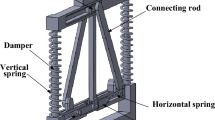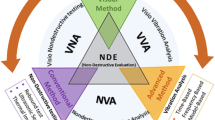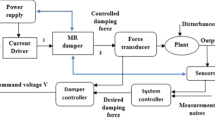Abstract
This study focuses on an algorithm for the simultaneous identification of Coulomb and viscous damping effects from free-vibration decrements in a damped linear single degree-of-freedom (DOF) mass-spring system. Analysis shows that both damping effects can indeed be separated. Numerical study of a combined-damping system demonstrates a perfect match between the simulation parameters and the estimated values. Experimental study includes two types of real systems. The method is applied to an experimental industrial bearing. Experimental results are compared with numerical simulations to illustrate the reliability of this method. An analysis provides conservative bounds on error estimates. An example of the effect of quantization error on the estimations is included.
Similar content being viewed by others
References
Helmholtz, H. L. F., 1877, On the Sensations of Tones as a Physical Basis for the Theory of Music, Dover, New York, 406 pp. Translation by A. J. Ellis of Die Lehre von dem Tonempfindungen, fourth edition, 1877; first edition published in 1863.
Rayleigh, Lord, The Theory of Sound, Vol. I, reprinted by Dover, New York, 1945, 1877, 46-51.
Lorenz, H., Lehrbuch der Technischen Physik, Erster Band: Technische Mechanik starrer Gebilde, Verlag von Julius Springer, Berlin, 1924.
Jacobsen, L. S. and Ayre, R. S., Engineering Vibrations, McGraw-Hill, New York, 1958.
Watari, A., Kikai-rikigaku, Kyouritsu, 1969.
Feeny, B. F. and Liang, J.W., ‘A decrement method for the simultaneous estimation of Coulomb and viscous friction’, Journal of Sound and Vibration 195(1), 1996, 149-154.
Dahl, P., ‘A solid friction model’, Technical Report Tor-0158(3197-18)-1, Aerospace Corp., El Segundo, CA, 1968.
Canudas de Wit C., Olsson H., Astrom K. J., and Lischinsky, P., ‘A new model for control of system with friction’, IEEE Transactions on Automatic Control 40(3), 1995, 419-425.
Harnoy, A., Friedland, B., and Rachoor, H., ‘Modeling and simulation of elastic and friction forces in lubricated bearing for precise motion control’, Wear 172, 1994, 155-165.
Liang, J. W. and Feeny, B. F., ‘Dynamical friction behavior in a forced oscillator with a compliant contact’, Journal of Applied Mechanics 65(1), 1997, 250-257.
Armstrong-Hélouvry, B., Dupont, P., and Canudas de Wit, C., ‘A survey of methods, analysis tools and computation methods for the control of machines with friction’, Automatica 30(7), 1994, 1083-1138.
Polycarpou, A. A. and Soom, A., ‘Two-dimensional models of boundary and mixed friction at a line contact’, Journal of Tribology 117, 1995, 178-184.
Ruina, A., ‘Constitutive relations for frictional slip’, in Mechanics of Geomaterials, Z. Bazant (ed.), Wiley, New York, 1985, pp. 169-187.
Dupont, P. E. and Kasturi, P. S., ‘Experimental investigation of friction dynamics associated with normal load’, in Proceedings of the 1995 Design Engineering Technical Conference, 3A, ASME DE-Vol. 84-1, ASME, New York, 1995, pp. 1109-1116.
Shaw, S.W., ‘On the dynamic response of a system with dry friction’, Journal of Sound and Vibration 108(2), 1986, 305-325.
Feeny, B. F. and Moon, F. C., ‘Chaos in a forced oscillator with dry friction: experiments and numerical modeling’, Journal of Sound and Vibration 170(3), 1994, 303-323.
Liang, J.-W., ‘Characterizing the low-order friction dynamics in a forced oscillator’, Ph.D. Thesis, Michigan State University, East Lansing, 1996.
Author information
Authors and Affiliations
Rights and permissions
About this article
Cite this article
Liang, J.W., Feeny, B.F. Identifying Coulomb and Viscous Friction from Free-Vibration Decrements. Nonlinear Dynamics 16, 337–347 (1998). https://doi.org/10.1023/A:1008213814102
Issue Date:
DOI: https://doi.org/10.1023/A:1008213814102




